

Jim Chanos and Stephen Roach Debate the Future of the Chinese Economy. Chanos, Roach Discuss Outlook for China's Economy. Slowing China. Exit from comment view mode.
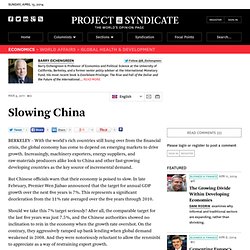
Click to hide this space BERKELEY – With the world’s rich countries still hung over from the financial crisis, the global economy has come to depend on emerging markets to drive growth. Increasingly, machinery exporters, energy suppliers, and raw-materials producers alike look to China and other fast-growing developing countries as the key source of incremental demand.
But Chinese officials warn that their economy is poised to slow. In late February, Premier Wen Jiabao announced that the target for annual GDP growth over the next five years is 7%. China's slowdown: Starts with a spark. Get Used to Slower Chinese Growth. As China fitfully tries to rebalance its economy, a small but rising number of Chinese economists are beginning to predict sharply lower annual growth rates of 6% to 7% over the next few years.
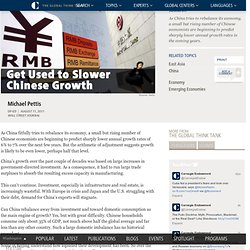
But the arithmetic of adjustment suggests growth is likely to be even lower, perhaps half that level. China's growth over the past couple of decades was based on large increases in government-directed investment. As a consequence, it had to run large trade surpluses to absorb the resulting excess capacity in manufacturing. This can't continue. Investment, especially in infrastructure and real estate, is increasingly wasteful. Can China rebalance away from investment and toward domestic consumption as the main engine of growth? Some in Beijing understand how lopsided their development has been. But achieving this goal is problematic, since it requires that household consumption grow four percentage points faster than GDP. This cheap borrowing comes at the expense of depositors.
Quand la Chine grisonnera, par Isabelle Attané. Avec 1,35 milliard de personnes en 2010, soit un habitant de la planète sur cinq, la Chine est le pays le plus peuplé du monde.
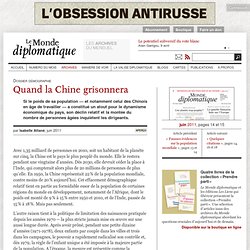
Elle le restera pendant une vingtaine d’années. Dès 2030, elle devrait céder la place à l’Inde, qui compterait alors plus de 20 millions de personnes de plus qu’elle. En 1950, la Chine représentait 22 % de la population mondiale, contre moins de 20 % aujourd’hui. Cet effacement démographique relatif tient en partie au formidable essor de la population de certaines régions du monde en développement, notamment de l’Afrique, dont le poids est monté de 9 % à 15 % entre 1950 et 2010, et de l’Inde, passée de 15 % à 18 %. Mais pas seulement. Debating a “Hard Landing” This Thursday, March 22, The Guardian (of the UK) published a friendly email “debate” between Andrew Batson, of Gavekal Dragonomics, and me over whether China’s economy faces a “hard landing” in 2012 — with me arguing that it does, and Andrew that it doesn’t. You can read our exchange below, or access the original here. The China bears grow ever gloomier, while the bulls maintain their confidence.
So will the world’s second largest economy see a hard landing in 2012 or can its leaders steer a steady course? Patrick Chovanec of Tsinghua University and Andrew Batson of Beijing-based consultancy Gavekal-Dragonomics debate. Dear Andrew, Michael Pettis Challenges The Economist to a Bet on China. The Economist says "China’s GDP, measured in nominal dollars, will be the world’s largest by 2018".
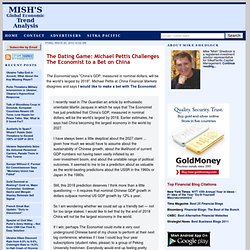
Michael Pettis at China Financial Markets disagrees and says I would like to make a bet with The Economist. I recently read in The Guardian an article by enthusiastic orientalist Martin Jacques in which he says that The Economist has just predicted that China’s GDP, measured in nominal dollars, will be the world’s largest by 2018. China’s ghost ships ply the bulk routes. From Reuters today comes an interesting story that complements this morning’s coal musings: China’s huge fleet of coastal ships, usually confined to plying the Chinese seaboard, has sailed out of the shadows to seek international business in yet another sign that China’s economy is slowing.The fleet, previously unnoticed by the global market, is suffering from a slowdown in China’s coastal trade amid weaker domestic demand from utilities and steel mills and a growing glut in Chinese coal and iron ore stockpiles.The vessels are now being forced to seek new business such as in the Indonesian coal trade, dealing a further blow to the depressed global dry bulk shipping market.
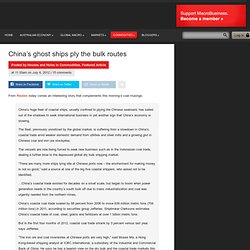
“There are many more ships lying idle at Chinese ports now – the environment for making money is not so good,” said a source at one of the big five coastal shippers, who asked not to be identified. Regular readers may recall that I posted recently on the weakness being signalled in the Chinese shipping indexes. China - Curators.
Roubini & Chovanec on China - macrobusiness.com.au. China's bad growth bet. Roubini On China's Unsustainable Growth Model. In an unexpected move to curb soaring inflation China hiked interest rates for the 4th time since October.

Premier Wen noted a threat to social stability and stated “Exorbitant” house price increases in some cities are a top public concern. Please consider China Raises Interest Rates to Counter Inflation Pressure China raised interest rates for the fourth time since the end of the global financial crisis to restrain inflation and limit the risk of asset bubbles in the fastest-growing major economy.The benchmark one-year lending rate will increase to 6.31 percent from 6.06 percent, effective tomorrow, the People’s Bank of China said on its website at the end of a national holiday. The one-year deposit rate rises to 3.25 percent from 3 percent.The move comes as a surprise to some, after Credit Suisse Group AG, Morgan Stanley and Bank of America-Merrill Lynch said officials may pause in tightening.
China's political economy - reading...